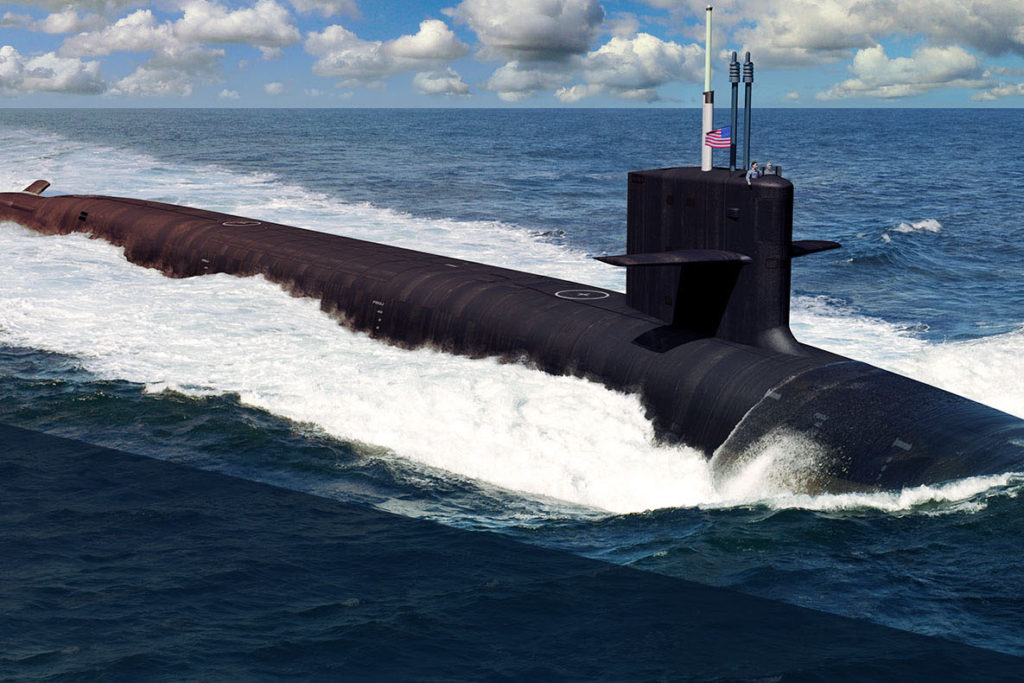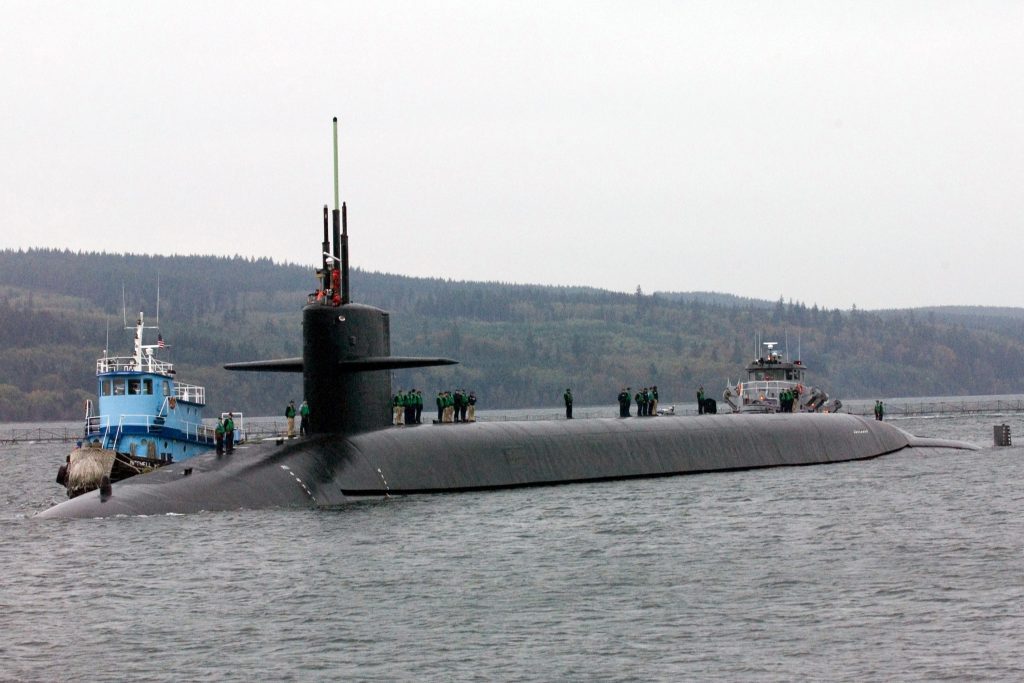Author: UConn Researchers Advance Submarine Power

May 15 2018 | A team of engineers led by UConn engineering professors Yang Cao and Ali Bazzi is conducting groundbreaking research on electric propulsion, moving the U.S. Navy closer to a shift in how submarines are powered.
With funding from the U.S. Department of Defense and Department of Energy, the researchers are developing electrical insulation for use in the manufacture of Next Generation Integrated Propulsion System (NGIPS) motors for military electric propulsion that will provide 50 percent higher power density.
The U.S. Navy is currently shifting from mechanical drive to electric drive in many propulsion systems for combat ships, just as plug-in electric vehicles run on electrical motors. The first modern electric drive submarine will be the Columbia class submarine, which replaces the Ohio class. The Columbia class is scheduled to begin construction in 2021 and enter service in 2031.
“On a nuclear submarine, space is tight,” says Cao, associate professor of electrical and computer engineering. “In order to fit electric drive systems in [the next generation attack class submarine], electric drive components will all need to be smaller.”
The improved insulation material enables the motor to be much smaller. Without it, says Cao, it would be almost impossible to fit electric drive propulsion systems on these future attack class submarines.
Author: Full Speed Ahead: Using Additive Manufacturing to Repair Ships at Sea
When a ship runs into trouble at sea, it can be time-consuming and disruptive to take it ashore to get it fixed. A team of UConn engineers has now developed a way for a ship’s crew to pinpoint the exact location of any mechanical trouble on board and, instead of taking the ship offline for maintenance, to repair or replace the part while the ship is still at sea.
The researchers, led by associate professor of materials science and engineering Rainer Hebert, have created a device that uses ceramics on additively manufactured metals to obtain signals about degradation or certain other potential problems, such as overheating. They are also developing a field-deployable manufacturing process that could produce replacement parts from electronic files using a 3-D printer on board ship after the metal-ceramic parts indicate failure or problems.
The new device can simultaneously carry the weight and resist temperature variants of existing components. (A change in temperature can signal a potential problem.) It then generates an electrical signal that alerts crew members, in real time, to the change in temperature and the amount of strain placed on that part.
Author: UConn Professor Finds New Way to Test Submarine Parts for Vibration
It goes without saying that being able to move around quietly is key to a submarine’s stealth.
The Navy has continued to develop ways to make submarines more stealthy such as quieter machinery and a new hull coating to better absorb sound. And now, a University of Connecticut professor and his graduate students have found a way to do vibration testing on submarine parts sooner in the design process.
Rich Christenson, a professor in the University of Connecticut’s Civil and Environmental Engineering Department, and his graduate students have adapted a method used by earthquake engineers to use shake tables to simulate how parts like a submarine motor, for example, will vibrate on a ship at sea. The shake tables are connected to computers, which tell the tables to move as the part would if it were sitting in water. The computers also run a mathematical model to see how the parts will respond when they are part of a larger system.
Author: Submarine Engineers Simulate Real-Time Conditions to Test Key Components

Existing laboratory test methods don’t allow submarine engineers to test how a motor will vibrate in real-world conditions on a ship at sea, so designers take the conservative approach to prepare for the worst.
But a team of UConn engineers has developed a method to test vibrating, manufactured components, using actuators and shake tables, sensors, and mathematical formulas that can replicate the system-level, real-time conditions.
As the U.S. Navy looks to redesign existing platforms and complete designs of new submarines, this will allow ship builders to test the system-level response of physical hardware components earlier in the design process, says Richard Christenson, professor of civil and environmental engineering at UConn.
Christenson and his students have taken an existing test method used in the field of earthquake engineering, called real-time hybrid substructuring (RTHS), and advanced the existing framework so they can apply it to the mechanical applications of vibration control and structural-born acoustics.
The technical challenge they face involves combining the physical specimen – the motor, or any other component of interest – with the numerical simulation of the rest of the ship and the surrounding water.
This is done in the UConn Structures Research Laboratory, where Christenson and his colleagues place the physical specimen on a shake table that can rotate and move it in any possible direction. Every millisecond during a test, the reaction forces at the base of the specimen where it is attached to the table are measured and sent to a real-time target computer. The computer runs a mathematical model of the remainder of the structural system, including any surrounding fluid, and commands the table to move as the base of the specimen would move if it were sitting in water.
Author: Congressman Courtney Comes to UConn

U.S. Congressman Joe Courtney (D-Conn.) visited the University of Connecticut’s Storrs campus last week to meet with researchers from the School of Engineering and tour several of the University’s state-of-the-art research centers.
“Congressman Courtney is a dedicated advocate of higher education and UConn is very grateful for his longstanding support,” said Provost and Executive Vice President for Academic Affairs, Craig H. Kennedy. “He understands the role and value that a public research university plays in advancing new discoveries, innovation, and knowledge with industry partners to drive economic growth throughout the state.”
The visit began at one of UConn’s most specialized R&D facilities, the Innovation Partnership Building (IPB) at the UConn Tech Park. Made possible through state investment in the $1.5 billion Next Generation Connecticut initiative, the IPB brings together world-class academic researchers with industry partners from the private sector. The unique space was specifically designed to fuel collaborative research between UConn scientists and businesses of all sizes, and to accelerate the development of ground-breaking technologies in materials science, additive manufacturing, cybersecurity, flexible electronics, energy, and other fields.
Some of Connecticut’s – and the world’s – leading corporations and industries are serving as anchor partners for the IPB, including United Technologies Corp., General Electric, Comcast, Pratt & Whitney, and Eversource.
Author: UConn Professor Finds New Way to Test Submarine Parts for Vibration
By Julia Bergman Day staff writer
 It goes without saying that being able to move around quietly is key to a submarine’s stealth.
It goes without saying that being able to move around quietly is key to a submarine’s stealth.
The Navy has continued to develop ways to make submarines more stealthy such as quieter machinery and a new hull coating to better absorb sound. And now, a University of Connecticut professor and his graduate students have found a way to do vibration testing on submarine parts sooner in the design process.
Rich Christenson, a professor in the University of Connecticut’s Civil and Environmental Engineering Department, and his graduate students have adapted a method used by earthquake engineers to use shake tables to simulate how parts like a submarine motor, for example, will vibrate on a ship at sea. The shake tables are connected to computers, which tell the tables to move as the part would if it were sitting in water. The computers also run a mathematical model to see how the parts will respond when they are part of a larger system.
Author: Designing a Smart Sensor Network for Tracking Submarines
By Office of the Vice President for Research | Original Article at UConn Today
A team of UConn engineers is developing an energy-efficient “smart sensor network” to track targets of interest, such as the proximity of enemy submarines or ships to Navy vessels.
The U.S. Navy currently uses underwater Intelligence, Surveillance, & Reconnaissance (ISR) sensor networks that run on full power, which can be a problem for long-term operations. The more accurate the sensor, the more power they consume.
The sensor networks currently being used could consist of several multi-modal sensor nodes, called sensor buoys, where each node acts independently and contains a diverse sensor suite, a data-processing unit, a transmitter and receiver, and a GPS device. The sensor suite can be composed of different types of sensors to detect and track targets, such as underwater microphones and active sonars.
Batteries typically burn out within a few days, just as cell phones suck up more power when running multiple operations.
Traditionally, these sensor nodes operate on full power, running all devices simultaneously, but the batteries that power them typically burn out within a few days of operation, just as cell phones suck up more power when running multiple operations. This causes sensing failures which, in turn, leads to holes in coverage and affects tracking performance.
This poses a challenge to the Navy, since it deploys thousands of acoustic sensor networks throughout the ocean, where battery replacement can be time-consuming or impossible.
To address the challenge, Shalabh Gupta, a UConn engineer and researcher at the National Institute for Undersea Vehicle Technology, devised the concept of a “smart sensor network” that is energy-efficient as well as resilient to failures.

In a smart sensor network, sensor nodes adapt their sensing modalities based on the information about the targets’ whereabouts. Thus, the nodes around the target, such as a ship or submarine, activate their high-power sensing devices to track the target accurately, pinpointing its location, velocity, and trajectory.
On the other hand, the nodes that are located farther away from the target cycle between low-power sensing and sleep states to minimize energy consumption while still remaining aware.
Thus, if a low-power sensor detects a target, the node switches to high-power sensing to track it. Similarly, the high-power sensing devices that are tracking the target predict the target’s trajectory and alert other sensors within range of the target’s path, so that they switch to high power. Once the target has passed outside of a sensor’s range, it reverts to low-power mode.
The smart sensor networks also provide resilience. If a few nodes in the network fail, then the nodes surrounding the hole in coverage formed by the failed nodes jointly optimize to expand their sensing ranges to cover the gap.
“These networks have to contain built-in, distributed intelligence,” says Gupta, an assistant professor of electrical and computer engineering.
His first research paper on the algorithm, coauthored by graduate student James Hare, was published online in IEEE Transactions on Cybernetics in August 2017.
With this advance, crews on ships and submarines will be able to track enemy watercraft with batteries that last about 60 to 90 percent longer, Gupta says.
Gupta’s lab has prototypes of the sensors for ground use, and has been talking with Navy personnel about using them for the underwater acoustic sensor network. He is currently seeking funding to build underwater sensors.
Author: Institute to help bulk up ‘Silicon Valley of undersea warfare,’ officials say
Former Defense Secretary Chuck Hagel once called southeastern New England “the Silicon Valley of undersea warfare.”
That vision is shared by the two major public universities in Connecticut and Rhode Island and submarine manufacturer Electric Boat, who have partnered to create a new institute that will develop a new generation of highly skilled naval engineers and accelerate research in the field of undersea technology.
The timing is right for the new National Institute for Undersea Vehicle Technology, headquartered at UConn’s Avery Point campus in Groton, said Michael Accorsi, senior associate dean of UConn’s School of Engineering, given the push to ramp up submarine production in the U.S.
“There’s a lot of other places in the country that would like to be doing this work,” Accorsi said. “It’s really important that this region is top of the nation in undersea technology.”
The Navy says it needs more attack submarines to maintain undersea dominance amid increased activity by the Chinese and Russians. Between attack submarines and a new fleet of ballistic-missile submarines, EB anticipates building 55 more subs in the next 20 years. The company is looking to hire 14,000 people in Connecticut and Rhode Island over the next 10 years to do that work.
Author: Undersea Manufacturing Ecosystem Taking Shape In Groton
By Rebecca Lurye, Hartford Courant
In a warehouse between the Poquonnock River and Groton’s Army National Guard base, engineers tinker with a vessel worn and weathered from months at sea.
It’s a Wave Glider, an unmanned craft the shape of a surfboard and equipped with artificial intelligence and sonar sensors that trail along 20 feet underwater. Called the Outpost system, this new-age vehicle developed by year-old startup ThayerMahan is an example of the changing industry of undersea warfare, once the exclusive domain of submarine builders like General Dynamics Electric Boat, headquartered just two miles away.
ThayerMahan also represents opportunity for Connecticut, as the state works to boost and organize an undersea warfare ecosystem that’s long lagged behind its robust aerospace community.
The Thames River Innovation Place, an initiative by the state’s innovation support entity CTNext, is forming Connecticut’s first network of parts makers for undersea technologies.
read more at The Hartford Courant
Author: Institute created to spur developments in undersea vehicles
By JENNIFER McDERMOTT, AP News
PROVIDENCE, R.I. (AP) — Two public universities have partnered with a U.S. Navy contractor to research undersea vehicle technology and train people to work in the field.
The University of Connecticut, University of Rhode Island and submarine manufacturer General Dynamics Electric Boat established the National Institute for Undersea Vehicle Technology at UConn’s coastal Avery Point campus in Groton, Connecticut, this month.
The universities received a $1.3 million grant from the Office of Naval Research to prepare students to work in shipbuilding.
There are hundreds of small companies working on Navy projects in Connecticut and Rhode Island and dozens of faculty members at the universities doing research for the Navy.
Electric Boat has facilities in both states. The Naval Undersea Warfare Center and Naval War College are also in Rhode Island. URI Professor Arun Shukla, co-director of the institute, said the institute will help bring everyone’s expertise together.

